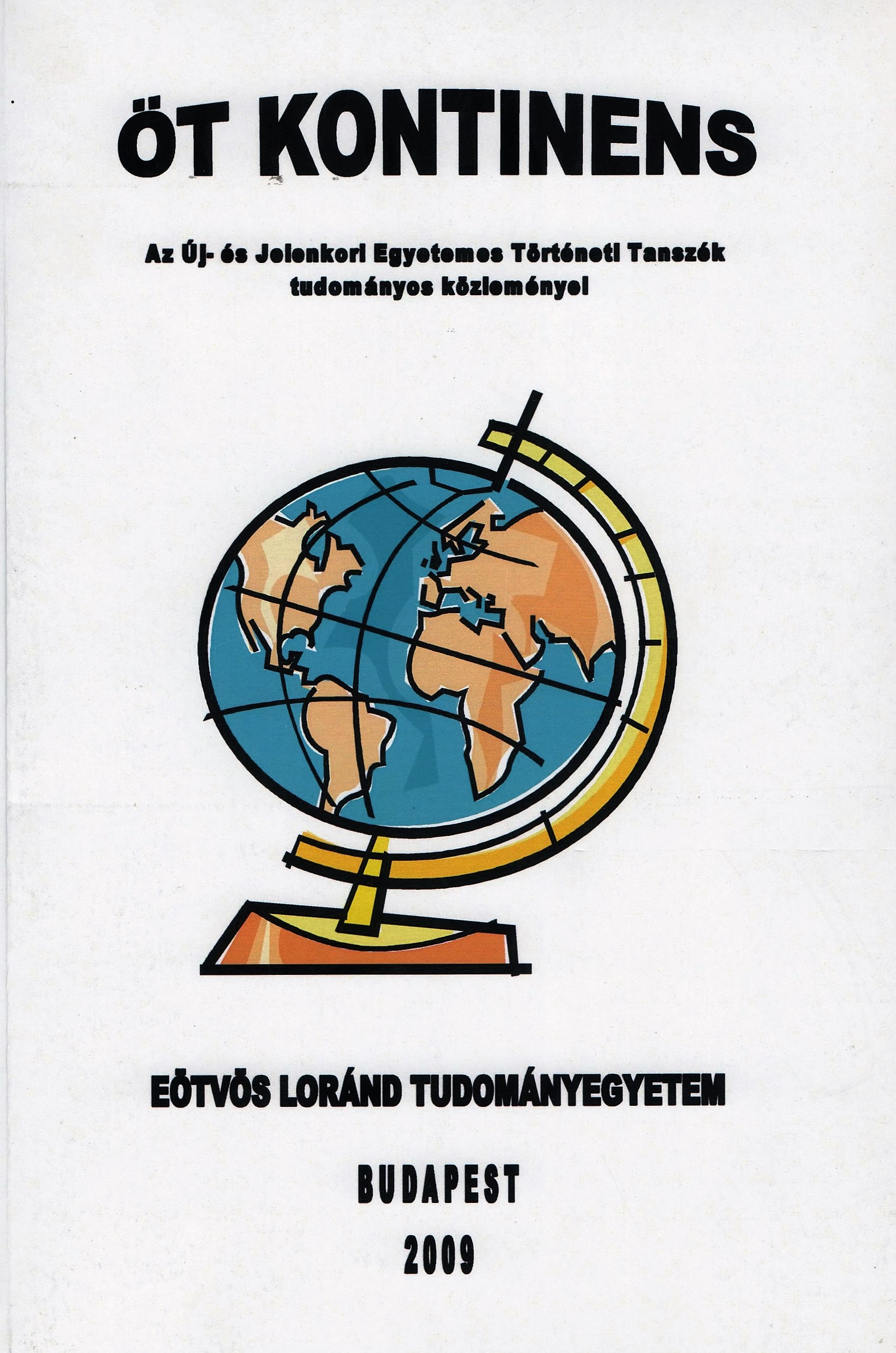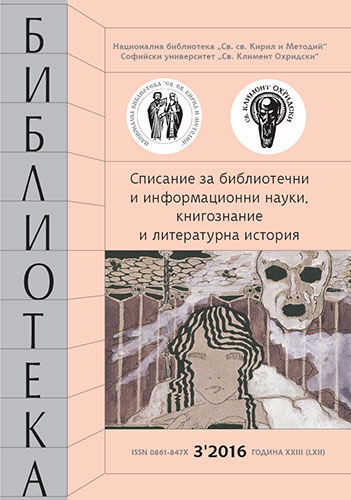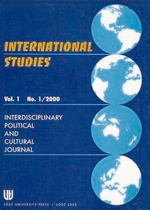
We kindly inform you that, as long as the subject affiliation of our 300.000+ articles is in progress, you might get unsufficient or no results on your third level or second level search. In this case, please broaden your search criteria.


The study deals wit the events in 1968. The author stresses that we can not narrow the students riots in 1968 to the Western countries and the United States. We can see similar movements in the countries of the Soviet Bloc.
More...
Aboriginal policy in Australia.
More...

The second part of the study about the American policy in Central Europe presents the Hungarian Territorial Integrity League. This league published the open letter to Wilson.
More...
The study analyses the novel of Dostoyevsky Brothers Karamazov and in the meantime the author presents Russia in the second part of the 19th century.
More...
Anglo-American special relations after 1945. The study presents these relations in the 20th century and the situation of Great Britain in the World from the end of the 19th century.
More...
The philosophical ideas of Henri Bergson and the reception in their literary and scientific works of Emmanuel Popdimitrov represent a broader topic.The article focuses on two things: first – Popdimitrov as a translator and promoter of the French philosopher, and second – the use of the semantic sequence of „bee – hive – honey“, rarely found in the Bulgarian symbolism, but common place for Popdimitrov mostly with the works of Henri Bergson, and also with Maurice Maeterlinck, Osip Mandelstam and other European poets of the modernism.
More...
The paper deals with the encounters and the partings of the artists of a brilliant poetical generation. It has been built on the reverse chronology of publications by N. Liliev and E. Dimitrov in the literary editions of Geo Milev, who was their junior, until they met each other on the pages of the Zveno magazine(1925–1914). Parallel to this plot about poets and literary projects falling asunder,in society forces are being united that will impose an anti-constitutional and non-parliamentary government in the country. The counterpart of the Zveno of 1914 – the young Modernist poets’ magazine – is the 1928 Zveno, the organ of the newly-established political circle that will persist in staging coup d'etat's and exercising political violence in recent Bulgarian history.
More...
The terms decadent and bohemia are not introduced here in their inherent,rich, cultural and historical dimensions, but as ideologically narrowed figures,used in the literary historical description of Bulgarian symbolism in the 60s,70s and 80s of the twentieth century. It is traced how the figure of the bohemian(the happy-go-lucky fellow, homeless, hedonist) pushes the figure of the decadent (introvert, pervert, Satanist) outside the field of the literary history while at the same time many facts are absolutely distorted, silenced, replaced,denied, in order to build a format of a harmless Bulgarian symbolism – thematically depleted, theoretically baseless, grounded, melodic, dialogic – which fits „organically“ in the sustainable realistic traditions of Bulgarian literature.
More...
The first play with a vampire motif in the history of Bulgarian literature is the subject of this article. Strashimirov’s drama is analyzed in juxtaposition with the Gothic-Byronic Western European tradition. The main dramatic structure around the love triangle is examined not simply as a social or a Romeo-and-Juliet type of conflict, but as a mirror-symmetry structure. In this way The Vampire is observed as a dramatic work not only with a single antihero vampire, but as an interpretation of vampirism as metaphorical ‘lexis’ of‘the dark side’ of the human being.
More...
The synesthesia and synchrony code set forth in the title leads us a way to the metatext synchronies-synesthesias in the articles ‘About Six Giants’ by Nikolay Liliev and ‘Modern Poetry’ of Geo Milev published in next-by copies(2, 3, 4, 5) of ‘Zveno’ magazine in 1914.We are interested in the aromas and colours identifying the decadent paradigm of ‘Zveno’ magazine.
More...
Emanuil Popdimitrov’s predestinate, passionate relationship to his homeland which had remained outside of Bulgaria’s boundaries, to the beautiful scenery of Kraiste, is a well-known fact. His poems „The Girl from Borderlands“and „Gruinska River“ are among his works that are regularly includedin anthologies. However, the composition that presents the most complete imagined picture of his native land, the idyllic poem „Svetla“, has been forgotten,unknown to the present-day readers. In this poem, Popdimitrov’s birthplace is recreated, called to mind, analyzed, its very beginnings are being evoked.
More...
Literary critics and scholars have long considered the poem „Transfiguration“as one of the focal works in Popdimitrov’s oeuvre. Yet, there are too few serious critical analyses of this innovative complex poem, integrating biblical themes. „Reflections on the Spiritual Essence in the Poem „Transfiguration“looks for and explores the different places in the grand trajectory of man’s tragic road. The combination of theological and literary analyses opens up unseen-so-far aspects of this sublime poem – an ambitious Bulgarian counterpart of Danthe’s grand opus.
More...
In his article „Native Art“, published in 1920 in the magazine Libra (Vezni),Geo Milev for the first time juxtaposed „art as a temple“ and „art as a street“, or tendentious art. He constructed an elitist conception of native art,in which the idea of art as a temple, as an expression of Universal Spirit, took a central place. The temple is the place of universal or native art, while thestreet is the place of people’s art. The mass production of art in the 1920s gave rise to the necessity to bring back its sacred meaning. If for Geo Milev, massor people’s art is tied to the village, with village life and strives to juxtapose itself against the universal art of the big cities, for Sirak Skitnik, the big city is precisely the place where mass art arises. Milev’s idea that art should return to„man’s primordial spiritual essence, man apart from his material transfigurations,re-evaluations and possessions, freed of everything that we today call material culture and civilization“, finds in Sirak Skitnik it’s continuation in the concept of returning to a contemporary primitive. The return to this primitive offers Bulgarian modernists from the 1920s the opportunity to rehabilitate certain artistic characteristics that were suppressed in the 19th century, namely irrationalism, spontaneity, naiveté, and the magical function of art.
More...
This article presents a short history of the origin and creation of the Almanac “Women and Russia,” which began as a samizdat underground publication devoted to the problem of women and childrearing in the USSR. The idea for creating such an Almanac originated in the mid 1970s in the Leningrad circle of ‘unofficial culture’, at the initiative of the artist Tatyana Mamonova, religious philosopher Tatyana Goricheva, and the women author Natasha Malachovska. The women writers featured in the first edition of the Almanac addressed not only questions about the social conditions prevailing in the USSR, but above all exposed the consequences for women living and functioning in a patriarchal social order, and ironically one where all the questions concerning ‘women’s rights’ were deemed to have been resolved in a progressive fashion much earlier. Not only is the substance of the Almanac important, but the circumstances surrounding its publication and the subsequent consequences related to its publishing also reveal the state of the ‘women’s movement’ in the USSR of that time. These include the reactions of the representatives of the dissident culture, the interventions of the security apparatus and the attendant repression of the women activists and its effect on their lives, and the support of feminist organizations from abroad. Each of the afore-mentioned reactions and consequences became an element of and shaped the everyday lives of the activists involved in the creation of the Almanac. The events related in this work confirm the opinion of those researchers who consider that the publication of the Almanac marked the beginning of the resurrection of the feminist movement in Russia.
More...
The “facts” of international politics constitute the first-order representations of political life and can be reflected in popular entertainment as second-order or fictional representations. This article demonstrates that discourses of popular culture are powerful and implicated in International Relations (IR) studies. The article makes two correlated claims: the first is that the humanist and anthropological methodology often used to analyse popculture could also be used to analyse international issues, if appropriately contextualized; the second claim is that a nation can manifest its ‘discourse’ in international politics via its popular culture, as soft power.
More...
This article explores the development in Bolivia under president Evo Morales, through a critical postcolonial approach. From a traditional liberal perspective, this article concludes that the liberal democratic system under Morales has not been deepening, though certain new participatory aspects of democracy, including socio-economic reforms have been carried out. In contrast,this article analyses to what extent the presidency of Evo Morales may be seen as the end of the postcolonialism, and the beginning of a new era in which Bolivia’s indigenous people finally have been incorporated into the forward development of a multi-ethnic society. By analysing issues such as time, nation,land, space, globalization and language, the conclusion is that the new constitution marks a fresh beginning, one beyond the colonial and postcolonial eras, for indigenous groups, but it will not bring back the old indigenous societies as was dominating the territory of today’s modern state.
More...
The aim of this article is to show how sport can matter in international relations. Sport can be a subject or a tool of international relations.It can be used by states or geopolitical blocks to display their alleged superiorityor any other desired characteristic. Governments may desire athletic victories,which are meant to imply, for example, the power of the state and its political and economic system. Participation in sport can also be used for political reasons on an international scale; a number of political objectives can be achieved by states by participating (or not) in sports events. Not only is sport affected by a country’s policies, but on certain occasions sports events can influence states.
More...
It is more than probable that the Commonwealth Games in 2014will be used by the Scottish government as a tool in the battle for independence.For the Scottish National Party (SNP), sport events constitute another opportunity to underline Scottish autonomy. During the last Olympic Games,SNP ministers refused to use the name “Team GB” in their message to the Scottish athletes. Nurturing Scottish pride during the Games has already begun,with the official mascot—the Clyde Thistle, which is Scotland’s national flower and emblem. The mascot of the Commonwealth Games has never waved the patriotic flag as it does now.
More...